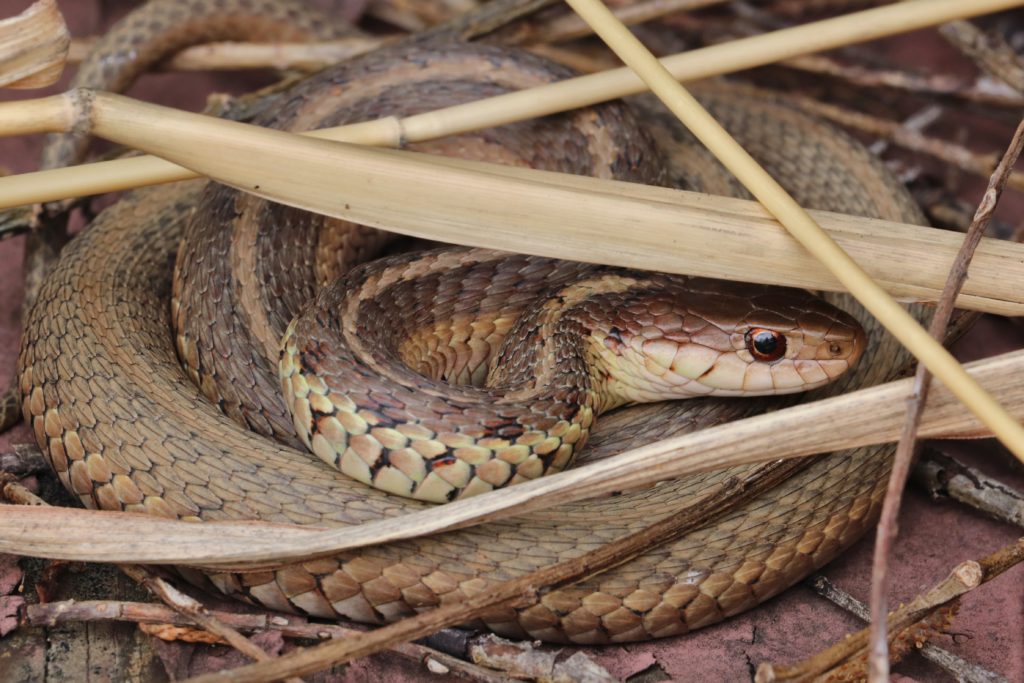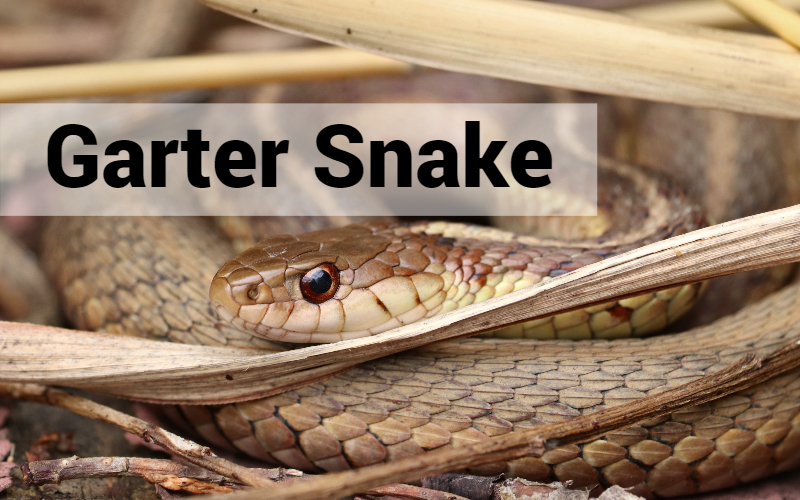Garter snakes have adapted to many different environments in the wild including scrubland and forests and they are usually found near water. Garter snakes are commonly available as captive bred but they are also wild collected. It is strongly advised that you only obtain captive bred or rescue animals. These snakes are now available in many captive bred colour morphs.
Behaviour

Garter snakes are small colubrid snakes that are not constrictors. They do not pose any dangers to children other than salmonella, which can be carried by any reptile. They are active during the day so they have excellent eyesight which they use along with their keen sense of smell to find and capture prey. They make great display pets because they are very alert and active. In the wild they are often found around water; streams, rivers, lakes and marshes.
Females are around 3ft long depending on species and males are usually 2ft or less in length. They are a fairly slim bodied snake, males more so than females. Babies are very small, average size at birth is 6-8 inches. The average lifespan in the wild may only be 4-5 years however they can live twice as long in captivity. Captives reaching over 10 years old have been documented when reptile health and wellness is prioritized along with proper snake supplies, reptile cleaning supplies, and snake habitat products.
Temperature
Naturally, garter snakes would be experiencing temperatures of around 85of in the sun. We try to provide this heat over 1/3 of the enclosure while letting the rest of the enclosure cool to 70of on the opposite side. To achieve this we attach a basking lamp to the ceiling of the enclosure on one side. This is controlled by a dimming thermostat to make sure that the temperature is kept correct throughout the day. Garter snakes will be able to reach the top of their enclosure without decorations to climb on so the basking lamp must be surrounded by a guard. The basking lamp is left on for 10-12 hours per day.
At night, all of the lights should go off and the enclosure should be completely dark. This should make sure that the snake has a clear day and night cycle.
During the day your temperatures will be much too warm and the heat mats thermostat should keep it off automatically. The heat mat will only begin to heat once the temperatures have dropped below 75of at night time.
Though the thermostats we sell are very reliable it is always best practice to monitor your temperatures with a thermometer. A 5of variance on the basking spot is nothing to worry about as long as your cool side is still cool. A simple dial thermometer on each side should be sufficient but digital probe thermometers are much more accurate.
Lighting
Garter snakes do not require UVB to use the calcium in their diet like other reptiles but it is still a beneficial addition to the enclosure. The snake would naturally be exposed to UV from sunlight in the wild and as we are trying to emulate nature in our enclosures, we recommend providing some UVB. A 5% T8 UVB tube, 2-5% T5 UVB tube or more powerful but smaller unit should be sufficient. The UV tube should be mounted to the ceiling at the back of the enclosure to provide a light gradient running parallel to the temperature gradient. There will be times when the snake will want less or no UVB so partial and full hiding spots should be placed all along the width of the enclosure.
Humidity
The correct humidity is essential to keep your snake’s respiratory system healthy and for normal skin shedding. Use a hygrometer to measure the humidity inside the vivarium, which should be around 50 to 60%. If it is too low, you can spray it with clean water. If it is too high, the vivarium will need more ventilation.
Cleaning
Garter snakes, as with most pets, require a clean environment to thrive. We recommend a spot clean as often as possible (every day) and a full clean every 4 weeks or so. If you are keeping the snake in a bio-active enclosure you can spot, clean and monitor the enclosure. It may still be a good item to change out the bedding a few times per year.
When cleaning the enclosure you should remove your animal, all decorations and all of the bedding. Once the enclosure is clear you can spray it all over with a reptile friendly disinfectant. These usually work very quickly and only need to be left for around 30 seconds, instructions can normally be found on the disinfectants packaging. Once the disinfectant has done its work it can be wiped away from the surfaces with a paper towel. In some cases, you might want to repeat this process a second time to ensure that the enclosure is thoroughly cleaned.
Your decorations can be cleaned in a similar method, simply spray them down with the disinfectant and rinse thoroughly with water before drying them off and putting them back into the enclosure. We recommend this process is done during the day time to make sure that the snake will be going back to a warm vivarium for at least an hour before the basking lamps are turned off for the night.
Handling
Garter snakes are not keen on being held for long periods. However, they may allow you to hold them for short periods, after they have settled in. Never grab your snake as this could stress it and may lead to struggling, biting or musking – when a strong smell is released from the snake – normal predator avoidance behaviours. The snake can be gently scooped up supporting the whole animal. The snake should not be taken out for so long that its core temperature drops. Five to ten minutes is a safe period, depending on the temperature outside of the vivarium.
Diet
Many keepers feed adults a frozen thawed rodent only diet, which is fine because this provides complete nutrition. However in the wild garters would eat a more varied live reptile food diet consisting of worms, amphibians, fish, and rodents, so it is a good idea to provide some variety in captivity. I prefer to feed both night crawlers and rodents, which can be found in pet stores or online reptile shops. Babies are easy to start on small cut up pieces of night crawlers. Most feeder fish contain an enzyme called thiaminase, which breaks down thiamine (vitamin B1). Long term exclusive feeding of these fish should be avoided, because doing so can lead to a potentially fatal vitamin deficiency. Garters do not eat crickets, mealworms or other insects.
A water dish large enough for the snake to completely submerge in is ideal. Garters love water and will often soak, especially before shedding. A water area large enough for swimming is ideal but not necessary. Garters will sometimes defecate in water, so it is important to check and change frequently. I prefer to use 16 ounce disposable deli cups, which are replaced at least once a week. This is the bare minimum size for adults.
Substrate
There are many substrates that will work for garter snakes. Popular choices are Aspen shavings, newspaper pellets or pulp crumbles, Cypress and Coco Husk like products. Substrates to avoid are sand, clay cat litter, cedar, pine or other aromatic wood products, or dirt from outside. Newspaper or paper towels can be used for babies but are not good choices for adults. Due to garter’s high metabolism, a deeper more absorbent substrate is preferable. Also, garters like to burrow, so it is good to provide at least an inch or two of substrate. I have used newspaper pellets or pulp, aspen, and wood pellets with good results.
Conclusion
Garter snakes are small colubrid snakes that are not constrictors. They do not pose any dangers to children other than salmonella, which can be carried by any reptile. They are active during the day so they have excellent eyesight which they use along with their keen sense of smell to find and capture prey. They make great display pets because they are very alert and active.




